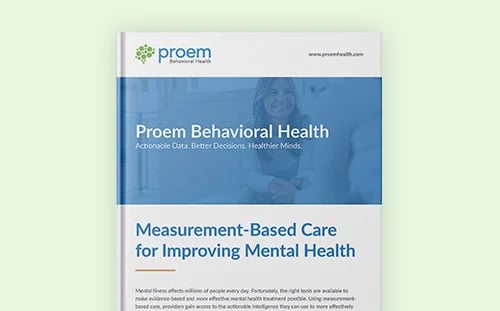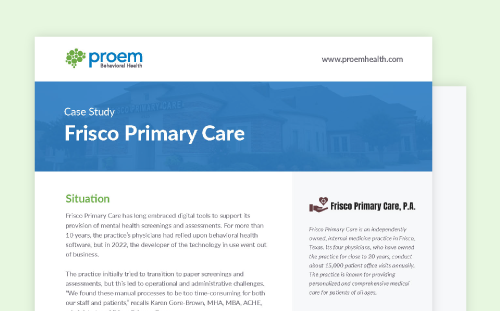According to the National Institute on Drug Abuse (NIDA), approximately half of people with a mental illness will develop a co-occurring substance use disorder (SUD) in their lifetimes and vice versa. One of the most common co-occurring combinations is depression and substance use.
-1.jpeg?width=768&height=513&name=AdobeStock_199101744_11zon%20(1)-1.jpeg)
The “Clinical Neuropsychology Study Guide and Board Review” reports that 10% to 30% of people with major depressive disorder (MDD) also have an SUD. Even more alarming is that one study of patients with SUD showed 81% experiencing moderate to severe depression.
To identify at-risk patients and provide effective treatment, SUD clinics, clinicians and healthcare organizations must understand the connection between depression and addiction. Here are five facts that highlight how they intertwine.
-
Multiple substances increase the risk
In one study that confirmed the bi-directional link between SUD and depression, researchers found that the connection is significantly stronger for people who use two versus one substance. Compared to individuals with either alcohol use disorder (AUD) or cannabis use disorder (CUD), people with both conditions were more likely to develop major depressive disorder.
Also, those with MDD were 4.5 times more likely to develop alcohol and cannabis dependence, categorized as part of the SUD diagnostic category in the “Diagnostic and Statistical Manual of Mental Disorders, Fifth Edition (DSM-5).” Screeners and other behavioral health tools must support efforts to screen for and evaluate multiple substance types so clinicians can effectively gauge risk levels and provide appropriate treatments. -
Influence is bi-directional and complex
Co-occurring addiction and mental illness sometimes have a clear causal pathway. For example, studies suggest frequent cannabis use increases a person’s risk of developing schizophrenia, especially among young men.
With depression and substance abuse, the link is bi-directional, which means that depression can prompt substance abuse, and individuals with an SUD may experience emotional distress that escalates to depression.
Establishing a clear causal pathway between depression and substance abuse is complicated, so clinicians should avoid making assumptions. In its treatment improvement protocol (TIP) for co-occurring disorders, the Substance Abuse and Mental Health Services Administration (SAMHSA) notes that environmental and medical factors can affect one or both disorders.
For example, research published in BMC Psychiatry shows that people with chronic pain and major depression have a higher risk of opioid misuse. When experienced together, these three conditions affect one another in multiple ways. For instance, pain experiences often contribute to depression, which increases the risk of disordered opioid use and often worsens functional outcomes.
The authors of the study published in BMC Psychiatry note, “The relationship may even be cyclical in nature, as greater pain-related functional interference may lead to more distress and depressive symptoms, which, in turn, may lead to lower levels of function due to the inhibitive physical, mental and social effects of the mental illness. The exact contribution of depressive symptoms and pain on functional interference is difficult to disentangle and likely varies across individual experiences.”
Furthermore, these interconnected factors have a reinforcing effect, potentially increasing both illnesses’ chronic and severe nature. Bottom line: De-tangling the causal nature of co-occurring MDD and SUD can be messy and complicated — if it can be done at all.
-
Co-occurrences are higher among certain populations
Young adults and those of lower socioeconomic status appear to have a higher risk of co-occurring depression and substance abuse. In one review published in JAMA Psychiatry, researchers found that adolescent cannabis users were more likely to develop depression in young adulthood. They were also more vulnerable to suicidal thinking in adolescence. Chronic cannabis users and those who increase their use later in adolescence are the most susceptible.
Unfortunately, research also indicates that most adolescents with co-occurring SUD and mental health disorders don’t receive the treatment they need. In a recent survey, scientists found that less than 12% of adolescents with these conditions received treatment for both.
In SAMHSA’s 2021 National Survey on Drug Use and Health, 13.5% of adults under 25 had an SUD and mental illness. This data points to the need for improved screenings among vulnerable populations and the provision of effective treatment as early as possible.
There also appears to be a link between socioeconomic status and co-occurring depression and substance abuse. Data has indicated that young adults with depression and an SUD had higher rates of unemployment and lower midlife incomes than those with one or neither disorder
-
Self-medication is a common contributing factor
Research suggests that depression preceded substance use more often than the reverse occurred. This finding supports the prevalence of the self-medication model, in which individuals turn to substance use to dampen the emotional distress of a mood disorder.
Self-medication is extremely common for people with mood and anxiety disorders. In one study, 21.9% to 24.1% of people with this type of disorder used substances to alleviate symptoms. Those who self-medicated had an increased risk of developing an SUD.
Given this connection, substance use screening must be a standard practice for patients with depression and anxiety so clinicians can provide integrated care as appropriate.
-
Depression and addiction share multiple risk and protective factors
Studies have identified multiple shared risk factors for depression and substance abuse, including:- Adverse childhood experiences, such as abuse, neglect, family violence or parental mental illness
- Lack of parental supervision in childhood and adolescence
- Family history of substance use, mental illness or suicidal behavior
- Bullying and other peer mistreatment
Researchers have also found that the counterparts of common risk factors can protect against both SUD and mental illnesses. For instance, strong family and peer connections reduce risk levels in both circumstances. Early diagnosis and treatment also improve the outlook for individuals with either or both conditions.
Integrated Care and Effective Assessment Tools Are Crucial to Recovery
SAMHSA strongly recommends integrated treatment because it offers the best potential for recovery from both depression and substance abuse. An integrated approach moves away from the disease model and toward a person-centered methodology, which addresses the integrated needs of the individual.
Integrated, person-first treatment has a stronger potential for symptom reduction, improved quality of life and higher function levels. To achieve this end, SAMHSA encourages clinicians to adopt a “no wrong door” practice that guides a person in need of treatment to the right providers, no matter where the patient goes first for care.
The interconnection and bidirectional influence of depression and substance abuse emphasizes a need for thorough, purposeful screening in clinical settings. Evidence-based screening tools allow clinicians to identify standalone and co-occurring disorders with less risk of mistaking one for the other.
Authors of the JAMA Psychiatry review also emphasize the need for effective screening across clinical disciplines, including primary care. Unfortunately, the JAMA Psychiatry review found that only 26% of pediatricians use clinically validated screening tools for substance use and just 11% use the Screening, Brief Intervention and Referral to Treatment (SBIRT) model.
SBIRT is SAMHSA’s model for expanding the delivery of early substance use intervention. Its goal is to integrate screening and assessment into more medical encounters, including primary care and hospitals, to reach people who wouldn’t otherwise present for substance use disorder.
Proem: Powering Effective Diagnosis and Treatment
To provide effective treatment for co-occurring depression and substance abuse, clinicians need reliable screening and assessment instruments. Proem meets this need with validated evidenced-based tools and an intuitive behavioral health solution that integrates into a clinic’s standard workflow.
Proem’s licensed digital screening and assessment instruments combine gold-standard assessment methods to simplify screening. Substance use disorder clinics and other providers can easily add these tools to their existing patient care models.
By adding routine screening to the clinical workflow, providers can catch more instances of mental illness-alcohol interactions and other co-occurring conditions. Contact Proem today to learn how we help make this possible and successful.





.png)
.jpeg)








